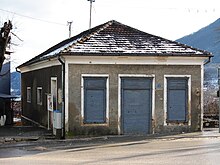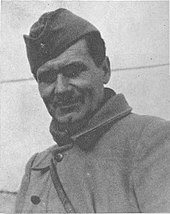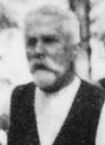
Democratic Federal Yugoslavia, also known as Democratic Federative Yugoslavia, was a provisional state established during World War II on 29 November 1943 through the Second Session of the Anti-Fascist Council for the National Liberation of Yugoslavia (AVNOJ). The National Committee for the Liberation of Yugoslavia (NKOJ) was its original executive body. Throughout its existence it was governed by Marshal Josip Broz Tito as prime minister.
The Anti-Fascist Council for the National Liberation of Yugoslavia, commonly abbreviated as the AVNOJ, was a deliberative and legislative body that was established in Bihać, Yugoslavia, in November 1942. It was established by Josip Broz Tito, the leader of the Yugoslav Partisans, an armed resistance movement led by the Communist Party of Yugoslavia to resist the Axis occupation of the country during World War II.
The Tito–Šubašić Agreements are the result of a series of negotiations conducted by the leader of the Yugoslav Partisans, Josip Broz Tito, and the prime minister of the Yugoslav government-in-exile, Ivan Šubašić, in the second half of 1944 and early 1945. The agreements were designed to create a coalition government in post–World War II Yugoslavia that would be composed of representatives of the National Committee for the Liberation of Yugoslavia and the government-in-exile.

The Yugoslav Partisans, or the National Liberation Army, officially the National Liberation Army and Partisan Detachments of Yugoslavia, was the communist-led anti-fascist resistance to the Axis powers in occupied Yugoslavia during World War II. Led by Josip Broz Tito, the Partisans are considered to be Europe's most effective anti-Axis resistance movement during World War II.

The League of Communists of Yugoslavia, known until 1952 as the Communist Party of Yugoslavia, was the founding and ruling party of SFR Yugoslavia. It was formed in 1919 as the main communist opposition party in the Kingdom of Serbs, Croats and Slovenes and after its initial successes in the elections, it was proscribed by the royal government and was at times harshly and violently suppressed. It remained an illegal underground group until World War II when, after the invasion of Yugoslavia in 1941, the military arm of the party, the Yugoslav Partisans, became embroiled in a bloody civil war and defeated the Axis powers and their local auxiliaries. After the liberation from foreign occupation in 1945, the party consolidated its power and established a one-party state, which existed in that form of government until 1990, a year prior to the start of the Yugoslav Wars and breakup of Yugoslavia.

The State Anti-Fascist Council for the National Liberation of Croatia, commonly abbreviated ZAVNOH, was first convened on 13–14 June 1943 in Otočac and Plitvice as the chief political representative body in World War II Axis-occupied Croatia. It was dominated by the Communist Party of Croatia, a nominally-independent political party active in the territory largely corresponding to present-day Croatia. Despite its nominal independence, the party was a de facto branch of the Josip Broz Tito-led Communist Party of Yugoslavia. ZAVNOH also included representatives or former members of peasant organisations, trade unions, the Croatian Peasant Party, and the Independent Democratic Party.

The Socialist Republic of Bosnia and Herzegovina, commonly referred to as Socialist Bosnia or simply Bosnia, was one of the six constituent federal states forming the Socialist Federal Republic of Yugoslavia. It was a predecessor of the modern-day Bosnia and Herzegovina, existing between 1945 and 1992, under a number of different formal names, including Democratic Bosnia and Herzegovina (1943–1946) and People's Republic of Bosnia and Herzegovina (1946–1963).

Đurađ "Đuro" Pucar "Stari" was a Yugoslav and Bosnian Serb politician.
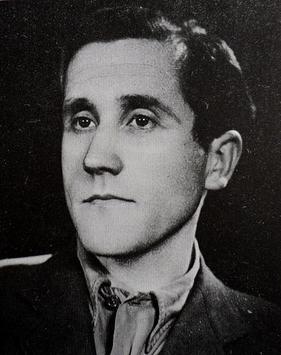
Osman Karabegović was a Yugoslav and Bosnian communist politician and a recipient of the Order of the People's Hero. He joined the Communist Party of Yugoslavia in 1932.
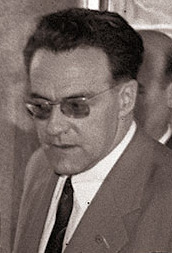
Hasan Brkić, often referred to as Aco, was a Yugoslav and Bosnian communist politician and a partisan. He was also the recipient of People's Hero of Yugoslavia. From 1963 to 1965 he was President of the Executive Council of the Socialist Republic of Bosnia and Herzegovina.
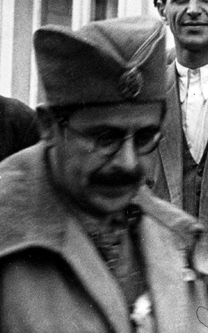
Ismet Popovac was a Bosnian Muslim lawyer and physician who led a Muslim Chetnik militia known as the Muslim People's Military Organization (MNVO) in Bosnia and Herzegovina during World War II. He was active in pre-war Yugoslav politics, becoming a member of the Serbian Muslim cultural organization Gajret and serving as the mayor of Konjic, a town in northern Herzegovina. He is also said to have been candidate for Vladko Maček's electoral list, but was left without a job in the Yugoslav state government after the creation of the Banovina of Croatia in August 1939.

Uroš Drenović was a Bosnian Serb military commander in the central Bosnia region of the fascist puppet state known as the Independent State of Croatia (NDH), led by the Ustaše, during World War II. After distinguishing himself in resisting the Ustaše alongside communist-led rebels, Drenović betrayed the communist-led Partisans and began to collaborate with the Ustaše, Italians and Germans against them.

Poles are one of 17 constitutionally recognized ethnic minorities in Bosnia and Herzegovina. They arrived during the Austro-Hungarian rule in Bosnia and Herzegovina and settled mostly in the north of Bosnia proper, bringing new technology and skilled manpower. Their destiny was tied closely to that of the Ukrainian minority, with whom they joined the Yugoslav Resistance after the Axis invasion of Yugoslavia. After the Second World War, Bosnian Poles faced difficulties with establishing their rights as a minority as well as persecution by local population and remaining fascist collaborators. This forced a vast majority to answer the Polish government's call for repatriation. There were around 30,000 Poles in Bosnia and Herzegovina in 1930, while their number today is estimated to be less than a thousand, with communities in the major cities of Sarajevo, Banja Luka, Zenica and Mostar.

The Women's Antifascist Front of Bosnia and Herzegovina, usually abbreviated to AFŽ BiH, was a mass organization in the People's Republic of Bosnia and Herzegovina. It was established by the Communist Party in February 1942, over a year before the republic itself, with the aim of mobilizing women in Bosnia and Herzegovina into the Partisan resistance against the Nazi occupation of Yugoslavia. It was one of the organizations which gave rise to the Women's Antifascist Front of Yugoslavia, the first congress of which was held in December 1942 in Bosanski Petrovac.

Boško Todorović was a Chetnik commander and delegate of the Chetnik leader Draža Mihailović in eastern Bosnia during World War II. During the interwar period he was a major in the Royal Yugoslav Army. Following the April 1941 Axis invasion of Yugoslavia he joined Mihailović's Chetnik movement. Initially considered a moderate, he was responsible for negotiating the transfer of parts of eastern Bosnia from Italian to Chetnik administration in November 1941, after which the Chetniks massacred hundreds of Muslim civilians in the region. He also signed a collaboration agreement with the Italians to protect the Serb population in Italian-occupied areas. He was killed by the Yugoslav Partisans in February 1942, either trying to evade capture, or he was executed after a brief trial when captured in possession of compromising documents regarding collaboration with the Italians.

The Croatian Partisans, officially the National Liberation Movement in Croatia, were part of the anti-fascist National Liberational Movement in the Axis-occupied Yugoslavia which was the most effective anti-Nazi resistance movement. It was led by Yugoslav revolutionary communists during the World War II. NOP was under the leadership of the League of Communists of Yugoslavia (KPJ) and supported by many others, with Croatian Peasant Party members contributing to it significantly. NOP units were able to temporarily or permanently liberate large parts of Croatia from occupying forces. Based on the NOP, the Federal Republic of Croatia was founded as a constituent of the Democratic Federal Yugoslavia. British Prime Minister Winston Churchill referred to the movement as "the Croatian miracle".
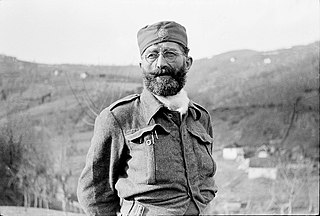
The Ba Congress, also known as the Saint Sava Congress or Great People's Congress, was a meeting of representatives of Draža Mihailović's Chetnik movement held between 25 and 28 January 1944 in the village of Ba in the German-occupied territory of Serbia during World War II. It sought to provide a political alternative to the plans for post-war Yugoslavia set out by the Chetniks' rivals, the communist-led Yugoslav Partisans, and attempted to reverse the decision of the major Allied powers to provide their exclusive support to the Yugoslav Partisans while withdrawing their support of the Chetniks.
The Croatian Republican Peasant Party was a political party formed from a faction split from the Croatian Peasant Party in 1941. The HSS was once the most popular political party among the Croats in the Kingdom of Yugoslavia, but after the Axis invasion of Yugoslavia, the HSS splintered in several groups including the faction that would become the HRSS. It joined the Yugoslav resistance led and dominated by the Communist Party of Yugoslavia (KPJ) and by its branch in Croatia – the Communist Party of Croatia (KPH). The prewar leader of the HSS Vladko Maček opted to wait for the war to end, while another faction joined the Ustaše movement that ruled the Axis puppet Independent State of Croatia (NDH).

During World War II, the Croatian Peasant Party splintered into several factions pursuing different policies and alliances. Prior to the German invasion of Yugoslavia, it was the most powerful political party among ethnic Croats, controlled the administration and police in Banovina of Croatia, and commanded two paramilitary organisations. After the successful invasion of the Kingdom of Yugoslavia in April 1941, Nazi Germany proposed that HSS leader Vladko Maček could rule Croatia as a puppet state. He declined, but the Ustaše agreed and proclaimed the Independent State of Croatia. Under duress, Maček called on Croats to support the regime. A splinter of the HSS and all HSS-controlled infrastructure went over to the Ustaše.
